|
Getting your Trinity Audio player ready...
|
Established in 1971
Arches National Park is an enchanting destination, renowned for its gorgeous and unique rock formations as well as its radiant range of colors. It’s a must-visit location at least once in your lifetime.
If you’ve ever seen Utah represented by a major landmark on a map, or seen a Utah license plate, or even just googled “Utah”, you’ve seen a little piece of Arches National Park. More specifically, we’re referring to the state’s most iconic natural feature – Delicate Arch. Standing 52 feet tall and poised at the edge of a cliff overlooking Salt Wash and the snowcapped La Sal mountains beyond, it’s easy to see why this landscape has symbolized the otherworldly natural beauty of Southern Utah for so long.
But Arches is far from being just a scenic drive to the foot of Delicate Arch. The park is home to the highest density of natural arches in the world. There are also astounding towers, hoodoos, fins, and other geological marvels in high concentration here. Pound for pound, you can see more unique natural spectacle in a day in Arches than almost anywhere else in the country.
If this description is making you want to crawl around on some slickrock and bask in the sun like a lizard, well, we know the feeling. So much so that we created this guide to Arches National Park, covering the reasons to go and the things to check out once you get there. So the next time a bout of spring fever gets you dreaming about howling at the moon over an ocean of red rock, you’ll know exactly what to do.
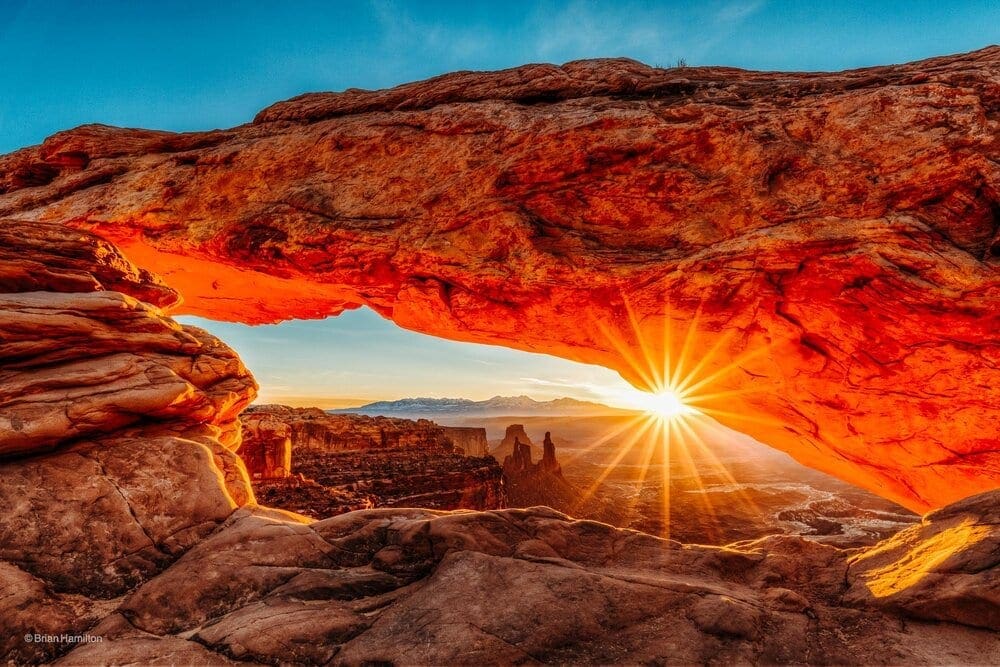
Sunrise Through Mesa Arch
History, Summarized
Looking out over the rocky, unforgiving landscape of Arches, it’s hard to imagine it was ever inhabited by people. But indeed, it was. In fact, humans have inhabited the surrounding region since the recession of the last ice age around 10,000 years ago. The ancient Fremont and Ancestral Puebloan cultures thrived here; hunting, gathering, practicing agriculture, and making art. Up until the 700’s they played out peaceful lives tucked away in the shelter of the huge sandstone cliffs of the area. Remnants of their existence can be found all over the Southwest in petroglyphs and dwellings. However, around 700 years ago, they mysteriously disappeared, an event that continues to puzzle archaeology to this day.
By the time Spanish missionaries arrived in the neighborhood of the Colorado River, they encountered modern-day Ute and Paiute Native Americans. For nearly a hundred years after the Spanish came and went, there was little presence of European settlers around Arches. In the mid-1850s the newly-arrived Mormon pioneers began pushing into the area. They built a mission, paving the way for prospectors, farmers, and ranchers, who settled the town of Moab in the 1880s. It didn’t take long for word to spread of the incredible rock formations in what is now Arches National Park.
The push for protecting those landforms began in 1923 when local railroad officials visited the area, hoping to protect it. Thinking ahead, they were already considering the potential of Arches as a future tourist destination. Seeing the value of the aesthetic beauty of the land, President Hoover named Arches National Monument in 1929. Over the course of the next forty years, the monument would be enlarged by both Franklin Delano Roosevelt and Lindon B. Johnson. National Park status was granted by President Nixon in 1971, but the size of the park was also significantly reduced.
Geology, In Layman’s Terms
The geological story of Arches National Park is all about three things: sandstone, weathering, and time. Lots of time. But it’s important to clarify that a very particular set of conditions must be met for sandstone arches to form naturally. Several hundred million years ago, the area that is now Arches was a massive salt bed, in some places thousands of feet thick. Over eons, two layers of sandstone formed on top of this: the more lightly-colored Navajo Sandstone layer and the classic red-orange Entrada Sandstone layer. Entrada sandstone is particularly important for forming prominent rock formations, as it weathers well while maintaining its shape. It’s this high concentration of exposed Entrada Sandstone that makes a geological phenomenon like Arches possible.
Essentially, all the formations in Arches were at one point a relatively flat plain of red rock with small creases and folds in its surface. Rainwater seeped into these and wore away vertical channels. Once the channels were large enough, currents of wind were directed into them, wearing the rock away more quickly. Over time, these channels become deep rifts that separated the plain into long, narrow fins.
These fins can be massive – hundreds of feet tall in places, and form in roughly straight lines. In parts of the park, the fins formed so densely that they create a maze of slots and ridges. These fins go on to become almost every kind of notable rock formation in the park. As the wind chips away at the flat walls of the fins they become thinner and thinner, until in some cases a hole forms in the center. And just like that, you’ve got an arch. With even more time, the “roof” of the arch can break, leaving free-standing towers and hoodos behind. On a more micro scale, the same processes of erosion can form tafoni and potholes which fill with rainwater and support life in the desert.
Desert Plants and Wildlife
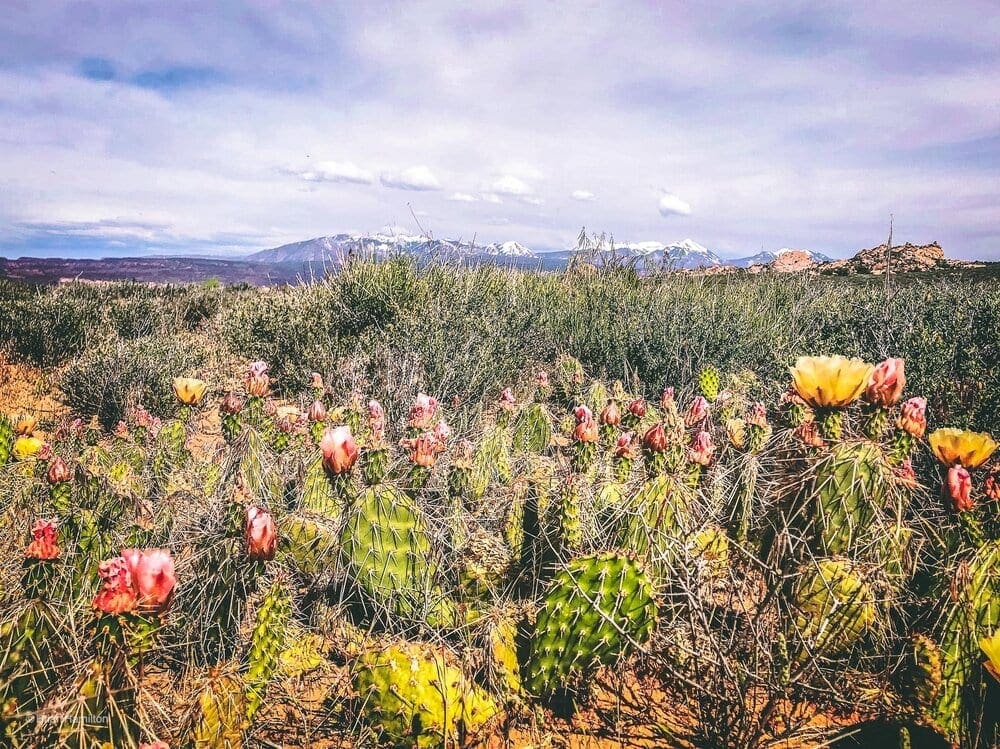
The climate of Arches is harsh and unforgiving. Though it may be hard to imagine during the 110-degree heat of July, the park also gets very cold in the winter. The high elevation desert isn’t well-suited to many living things, but there are a few species that do quite well for themselves here. You could probably guess most of them: prickly pear cactus, juniper trees, yucca, piñon pines, datura, and some grasses make up most of the plant life in the park.
But there are also leafy trees like cottonwoods and willows, and flowers like monkey flower and columbine in some of the wetter nooks and crannies. This plant community is able to exist because of biological soil crust, a thick carpet of microscopic living things that allows seeds to propagate and catches water. These crusts are more fragile than they look. A single misplaced footprint can kill everything in the crust, and can take decades to recover.
And where there are plants, there are animals to eat them, and animals to eat those animals. Reptiles fare pretty well in the high desert, despite the cold winters. Lizards and rattlesnakes can be found all over the park. There are also a fair amount of mammals around, if you know where to look. Desert bighorns, cougars, and mule deer are common in the area. And of course, birds persist almost everywhere. Canyon wrens, scrub jays, and peregrine falcons are all easy to spot in Arches. There are even a few species of frogs and toads that are able to persist in Arches.
The Main Attractions
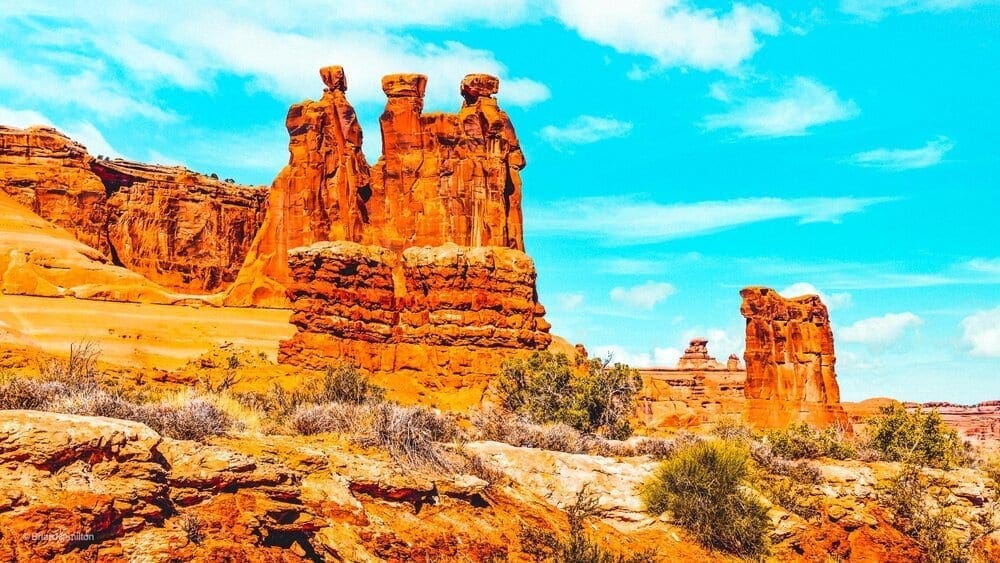
Immediately upon entering the park, you’ll start seeing things that will make you want to pull over and get your camera out. It’s a great idea to take some time to do the main scenic drive through the park right off the bat. Along the scenic drive are notable features like the Three Gossips, Balanced Rock, and the Fiery Furnace, which you can view from an overlook.
While making the rounds, a short detour into the Windows Section will provide a great bang for your buck. You’ll be able to see some of the largest arches in the park from the road here, and most of them are easily hikeable, too. Another quick stop-off on the scenic drive is the Delicate Arch Viewpoint, a good teaser if you plan to do the hike later. On the way back to the main drag from the Delicate Arch Viewpoint, you can stop at Wolfe Ranch. The ranch was built in the early 1900s, and just up a short hike up the trail is a panel of pictographs proving the area was inhabited long before that.
The scenic drive ends at Devils Garden, which is a hub for some of the more intense hikes in the park. It’s also the only campground in Arches. A quick hike from the parking lot will get you to Landscape Arch, the fifth longest in the world. Also easily accessible is Sand Dune Arch, tucked away in a shady alcove between two immense fins.
This laundry list of premium photo-ops can be knocked out in half day, or a full day if you take a few short hikes. It’s a quick way to get familiar with the park, or to check off most of the main attractions if you only have a day. But if you want to get up close and personal with Arches, you’d be well advised to hit the trail.
Hiking Trails
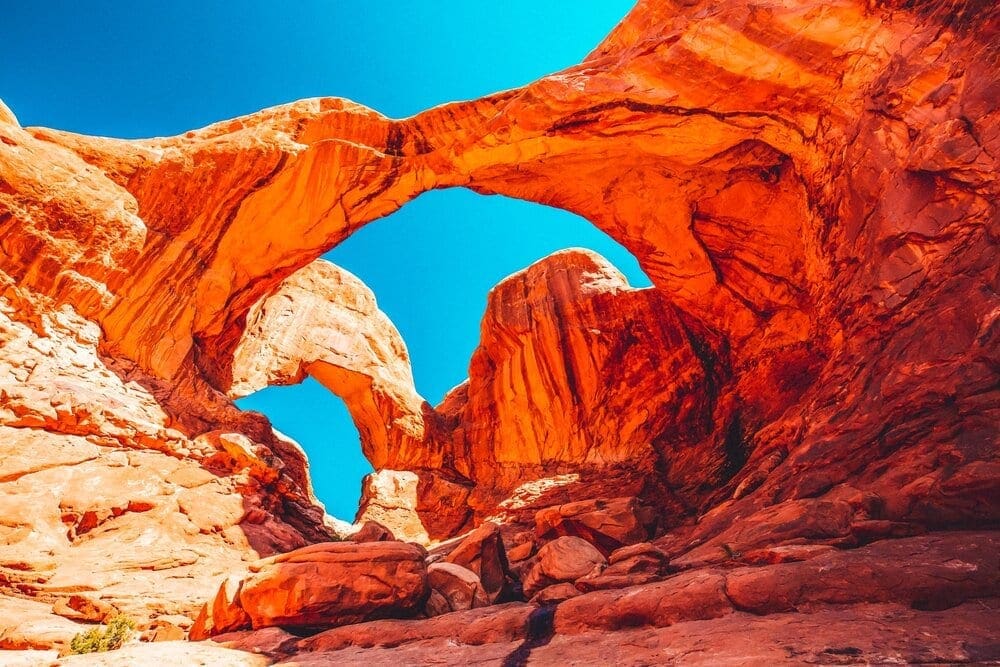
There are plenty of easy options for hiking in Arches: the Windows Loop, Double Arch, the Upper Delicate Arch Viewpoint, and the previously mentioned Landscape Arch and Sand Dune Arch trails are all easy enough for most people to handle. But the best views in the park take a little work to get to.
The Delicate Arch trail is rated strenuous and traverses open slickrock with no cover from the sun. In Devils Garden, you can go 4.1 miles round trip to Double O Arch, passing Landscape Arch and several others in the process. If you want to make it a half day, finishing the Primitive Trail of Devils Garden will take you to Dark Angel and Private Arch, through some exposed sections of trail over narrow ledges.
If you want to get further off the beaten path, head to the northeast corner of the park and hike to Tower Arch. This trail crosses through Klondike Bluffs, past the Marching Men to a lonely arch set under an imposing stone tower. Be advised that the road is dirt and may be impassible after rain.
Camping
Waking up in the park is an enviable spot to find yourself, if you can get a spot, that is. There is just one campground in the park, and in the busy season it is usually booked solid. Devils Garden campground is in high demand, located right in the center of the action. You can reserve one of the 51 campsites here up to six months in advance, and you should, if you can. But if you can’t, don’t worry too much. There are plenty of great spots to camp just outside Arches as well.
Canyoneering
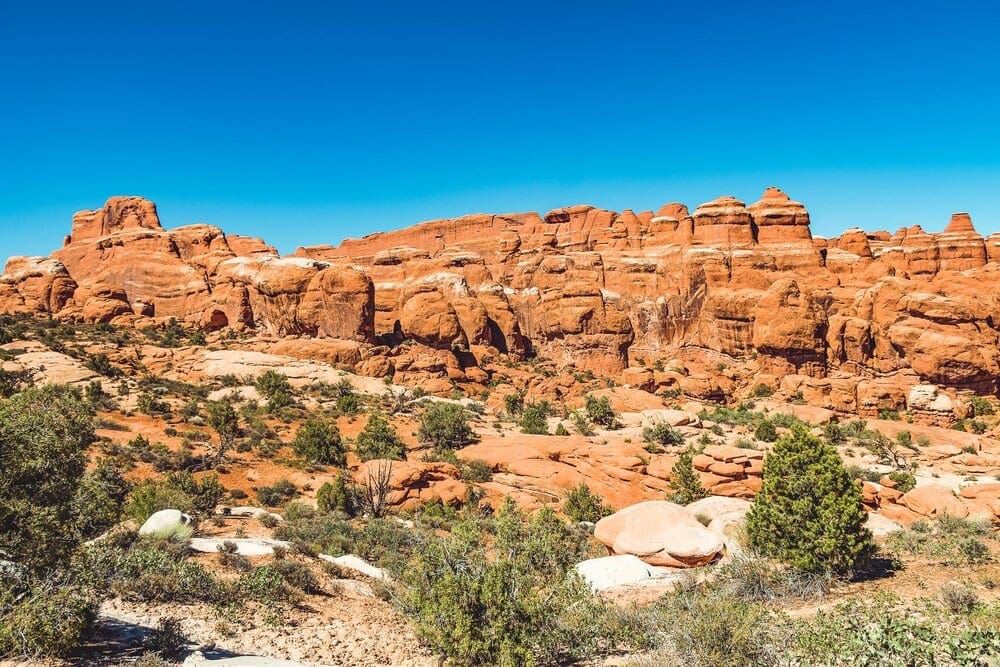
Fiery Furnace Overlook in Arches National Park, Utah.
Whether you’re entirely new to the sport of canyoneering or already have the gear and know-how for technical canyons, Arches has a wide variety of options to satisfy all tastes. The first and foremost of these is the Fiery Furnace, which deserves some explanation of its own.
The Furnace is an incredibly dense concentration of fins and slots which forms what can only be described as a literal labyrinth of stone. There are hundreds if not thousands of ways to get through the Fiery Furnace, and only one of them is marked. This allows visitors to choose one of two options for exploring it. You can take a guided tour along the marked route, which passes some of the noteworthy features inside. For beginners, this is the way to go. Or, you can buy a backcountry permit and get lost inside, using your own sense of direction to navigate back out.
Luckily, the Furnace is relatively small and there aren’t many dead ends inside, so “getting lost” isn’t quite as risky as it sounds. When in doubt you can just move in one direction and eventually you’ll come to the edge. As long as you follow the rules for maintaining a low impact inside, you can hike, stem, scramble, or rappel to just about anywhere inside the Furnace. It’s the ultimate freeform rock jungle gym.
If you want to get your hands dirty with some fun scrambling and stemming, the Furnace will keep you entertained forever. And if you’re looking to bust your rope out and do some rappelling, there’s no shortage of opportunities for that, either. There are two marked technical routes in the Furnace: Lomatium and Krill Canyons. But if you have the skills and equipment to build a non-permanent anchor, nothing is off-limits. There are hidden pockets deep in the Furnace that have rarely, if ever, seen human visitors because of how difficult they are to get to. If that doesn’t get you itching for some exploring, you ought to get your head checked.
Outside the Furnace, there are technical canyoneering routes at the Great Wall, in Lost Spring Canyon, in and around Park Avenue, at the Petrified Dunes, and to the top of Elephant Butte in the Windows. Elephant Butte is probably the most popular of these. It ascends to the top of the highest point in Arches, giving views of everything from the La Sal Mountains to Canyonlands National Park to the west.
Climbing
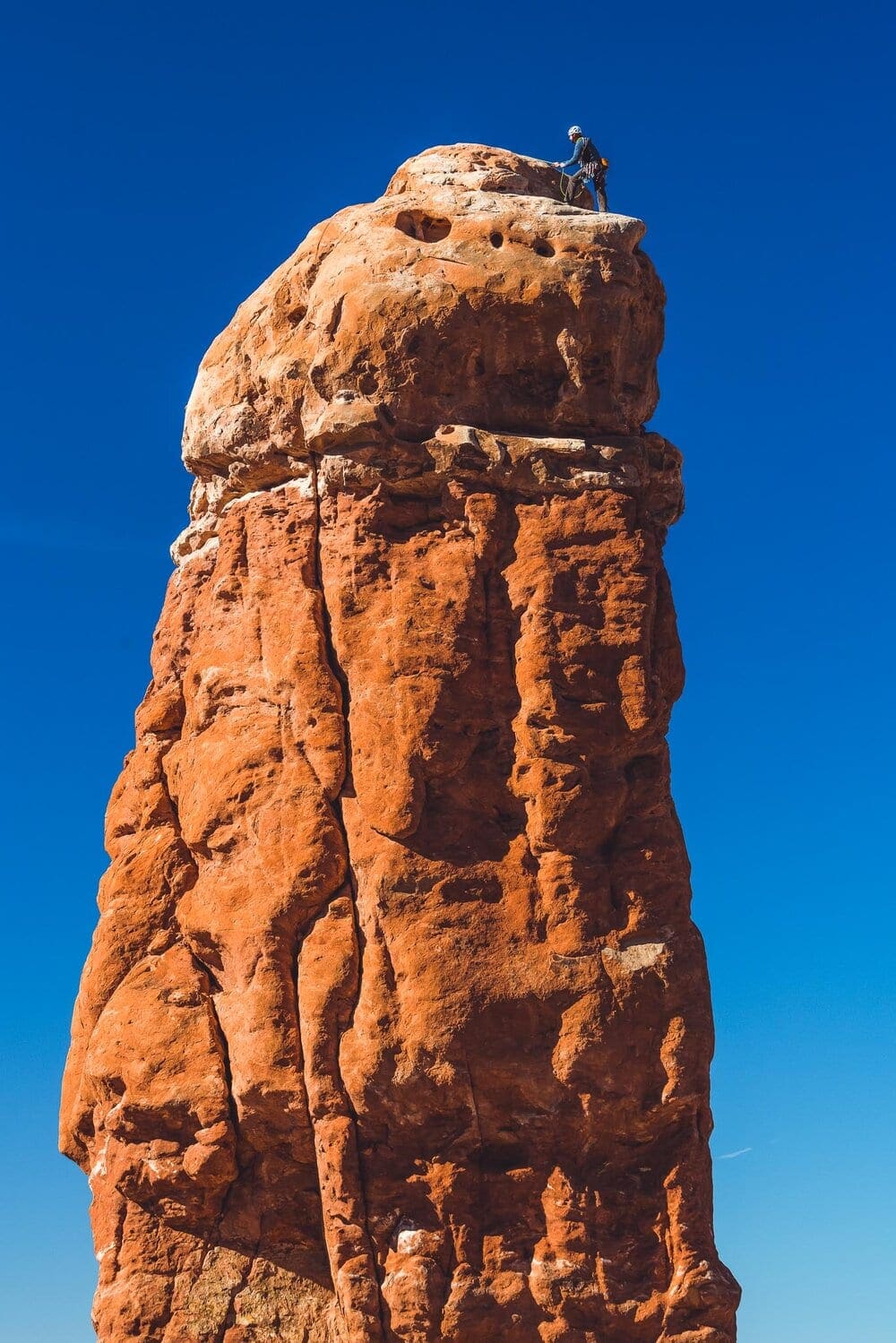
Owl Rock is a classic climb in the Garden of Eden at Arches National Park, Utah.
The main climbing destinations in Arches are the spectacular towers of the area. Classics like Owl Rock, Pickle Rock, The Marching Men, The Three Gossips, and the Tower of Babel will offer unique challenges to trad climbers. You’ll notice pretty quickly that there is a fairly high threshold for difficulty in Arches. Routes range from 5.7-5.12, with the majority falling in the 5.9-5.11 range. Be sure to get a permit and know the ins and outs of sandstone climbing before you go.
4×4 and Off-roading
Most of the prominent sights of Arches are easily accessible from a paved road. But if you want to get some dirt on the tires, there is one worthy route on the west side of the park that will reward your efforts. The Eye of The Whale and Tower Arch Loop charts a long off-road course to two amazing places most visitors don’t even think to investigate. It can be done in either direction, starting at Devils Garden and taking on the Tower Arch Trail (which is more difficult) before heading southeast to Herdina Park and Eye of The Whale Arch, or vice versa. Both stops along the trail are worth the time to get out and explore. There aren’t many places in Arches where you’ll get some time to yourself. In fact, these two may be the only ones.
Nearby Cities
The main entrance of Arches is essentially within the city limits of Moab. You can get everything you need in the way of supplies here, as well as a bite to eat or a cold beer. We’ve covered Moab in depth before and recommend reading up before you head to Arches. It’s the first and last stop to every desert adventure you might have in Southern Utah.
Millions of Years in The Making
In a word, Arches is the artwork of nature on display. And mother earth is a slow, deliberate artist. Every carefully sculpted spire or swath of rock in the park has taken hundreds of millions of years to appear in its current state. Whether you decide to take a single afternoon or an entire week, Arches will leave you awestruck and enamored. But don’t take our word for it, go see for yourself.
Skyblue Overland Strongly Recommends That You Enroll With Global Rescue Prior To Embarking On Your Next Adventure.
Purchase a Global Rescue membership for your next adventure and travel with peace of mind. Single trip, annual and family options are available.
Memberships start at $119.









